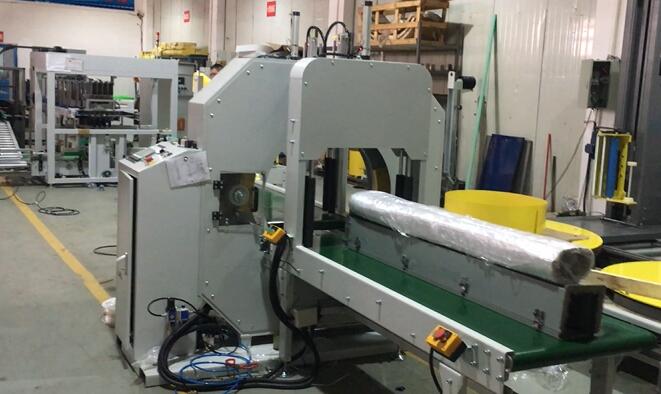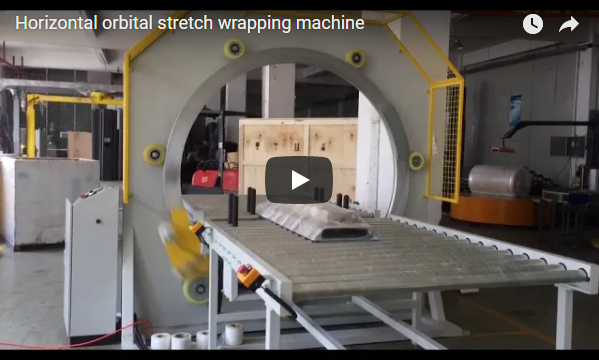Mastering the Wrap: A Deep Dive into Horizontal Orbital Stretch Wrapping Machines
Wrapping long, cumbersome items like pipes, timber bundles, extrusions, or textiles presents unique challenges in logistics and manufacturing. Ensuring consistent tension, complete coverage, and efficient throughput can be difficult with manual methods or traditional pallet wrappers. Enter the Horizontal Orbital Stretch Wrapping Machine – a specialized automated solution designed specifically for these demanding applications.
This isn't just about wrapping; it's about enhancing product protection, boosting operational efficiency, and presenting your products professionally. Let's explore the mechanics, benefits, and key considerations of these powerful machines.
1. Unpacking the Technology: How Orbital Wrappers Function
Unlike turntable or rotary arm wrappers where the load often rotates, a horizontal orbital stretch wrapper keeps the product relatively stationary, moving it horizontally through a rotating ring. This ring carries the stretch film roll.
- Loading: The long product is placed onto the machine's conveyor system (often powered rollers or belts).
- Wrapping Cycle: As the product feeds horizontally, the ring assembly rotates around it, dispensing the stretch film. This orbital motion ensures the film is applied evenly along the entire length.
- Film Application: A specialized film carriage on the ring maintains consistent film tension and pre-stretch (if applicable), optimizing film usage and load security.
- Cutting & Sealing: Once the product passes through, automated systems typically clamp, cut, and seal the film tail, preparing the machine for the next item.
The core advantage here lies in the ability to securely wrap products of virtually unlimited length with consistent overlap and tension, something impractical with other methods.

2. Key Technical Parameters & Customization Potential
Horizontal orbital wrappers are not one-size-fits-all. Their specifications are crucial for matching the machine to the application:
- Ring Diameter: Determines the maximum cross-sectional dimension (Width x Height) of the product that can pass through. Common sizes range significantly based on industry needs.
- Ring Rotation Speed (RPM): Impacts the wrapping speed and overall throughput. Adjustable settings allow balancing speed with wrap quality.
- Conveyor Speed (m/min): Needs to be synchronized with the ring speed to achieve the desired film overlap percentage. Variable speed control is standard.
- Film Carriage System: Defines pre-stretch capabilities (mechanical or powered, fixed or variable ratios – often up to 250-300%), tension control mechanisms, and compatible film roll dimensions (width, core diameter).
- Control System: Typically PLC-based (Programmable Logic Controller), offering user-friendly interfaces (HMI screens) to set parameters like wrap counts at ends, overlap percentage, tension levels, and store different wrapping programs for various products.
- Construction & Safety: Robust frame design, safety fencing, light curtains, and emergency stops are essential features.
From experience, the level of customization is a key differentiator. Options can include top pressure rollers for unstable loads, specialized conveyor systems, automatic film roll changers, and integration with upstream and downstream automation.
3. The Business Case: Tangible Benefits of Orbital Wrapping
Investing in a horizontal orbital stretch wrapper translates to measurable improvements:
- Superior Product Protection: Provides a tight, uniform barrier against moisture, dust, dirt, UV radiation (with specific films), and scratches during handling, storage, and transit. It effectively bundles multiple items securely.
- Significant Efficiency Gains: Drastically reduces manual labor requirements and associated costs. Automated wrapping is significantly faster and more consistent than manual wrapping, boosting overall throughput.
- Optimized Film Consumption: Precise tension control and pre-stretch capabilities maximize the yield from each film roll, leading to lower material costs compared to manual or less sophisticated methods. Consistency eliminates waste from uneven application.
- Enhanced Load Stability & Presentation: A professionally wrapped product not only looks better but is also more stable and easier to handle with forklifts or cranes, reducing the risk of damage.
- Versatility Across Industries: Ideal for manufacturers and distributors in sectors like:
- Building materials (timber, PVC pipes, insulation panels)
- Metals (aluminum extrusions, steel bars, copper tubing)
- Plastics (profiles, conduits)
- Textiles (carpet rolls, fabric bolts)
- Furniture (components, flat-packs)
4. Real-World Insights: What to Expect
Having seen these machines in action across various facilities, a few practical points stand out. The transition from manual wrapping is often transformative – what previously took minutes and multiple personnel can often be accomplished in under a minute by the machine. The consistency is remarkable; every product receives the same level of protection and stability, which significantly reduces damage claims and improves customer satisfaction.
However, achieving optimal performance relies on proper setup – calibrating tension, speeds, and overlap for your specific product and film is crucial. Regular maintenance, particularly of the film carriage and rotating ring components, is also key to long-term reliability.
5. Selecting the Right Horizontal Orbital Wrapper
Choosing the best machine involves considering:
- Product Dimensions & Weight: Ensure the ring size and conveyor capacity match your largest and heaviest items.
- Throughput Requirements: Match the machine's speed capabilities (ring RPM, conveyor speed) to your production output.
- Level of Automation: Decide between semi-automatic (operator starts cycle) or fully automatic (integrated into a line).
- Film Specifications: Consider the type, gauge, and pre-stretch percentage your application requires.
- Budget vs. Features: Balance initial investment against long-term savings from efficiency, film usage, and damage reduction.
Conclusion: A Strategic Investment in Packaging
The Horizontal Orbital Stretch Wrapping Machine represents a significant step up in packaging automation for long or irregular products. Its ability to deliver consistent, high-quality wrapping enhances product protection, boosts operational speed, reduces labor and material costs, and improves the overall professionalism of your shipped goods. While the initial investment requires consideration, the long-term ROI derived from these benefits makes it an essential tool for many modern manufacturing and logistics operations.
Explore tailored solutions for your specific needs:
https://www.fhopepack.com/Horizontal_wrapping_machine.html
For inquiries or further technical details, feel free to reach out:
info@fhopepack.com


